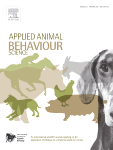Document type scientific review published in Biology Letters
Author: Silvia Leonetti, Giulia Cimarelli, Taylor A. Hersh†, Andrea Ravignani
Preview: Tail wagging is a conspicuous behaviour in domestic dogs (Canis familiaris). Despite how much meaning humans attribute to this display, its quantitative description and evolutionary history are rarely studied. We summarize what is known about the mechanism, ontogeny, function and evolution of this behaviour. We suggest two hypotheses to explain its increased occurrence and frequency in dogs compared to other canids. During the domestication process, enhanced rhythmic tail wagging behaviour could have (i) arisen as a by-product of selection for other traits, such as docility and tameness, or (ii) been directly selected by humans, due to our proclivity for rhythmic stimuli. We invite testing of these hypotheses through neurobiological and ethological experiments, which will shed light on one of the most readily observed yet understudied animal behaviours. Targeted tail wagging research can be a window into both canine ethology and the evolutionary history of characteristic human traits, such as our ability to perceive and produce rhythmic behaviours.
Publication mentioned in Science on January 16, 2024: What does your dog's tail wag really mean?




